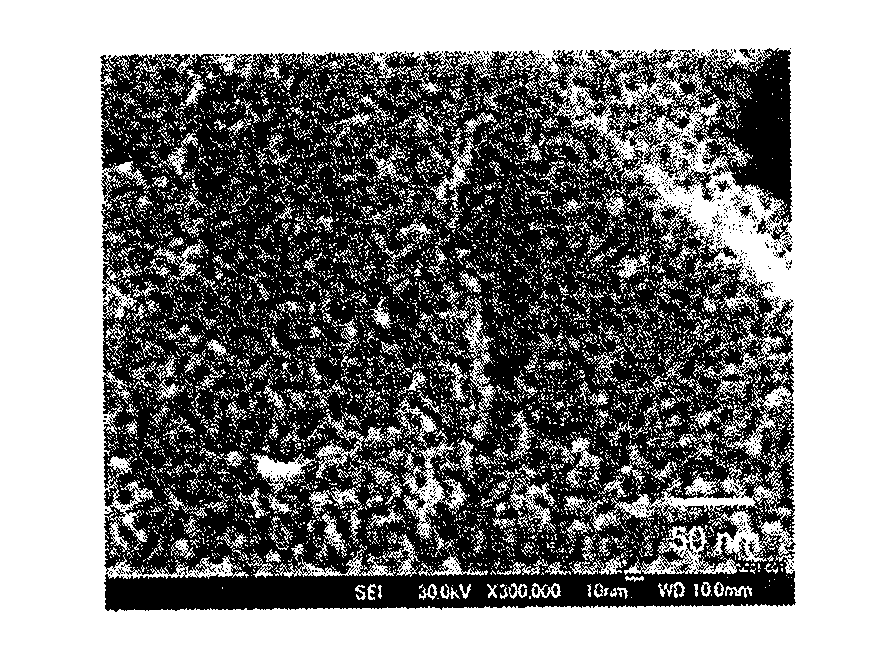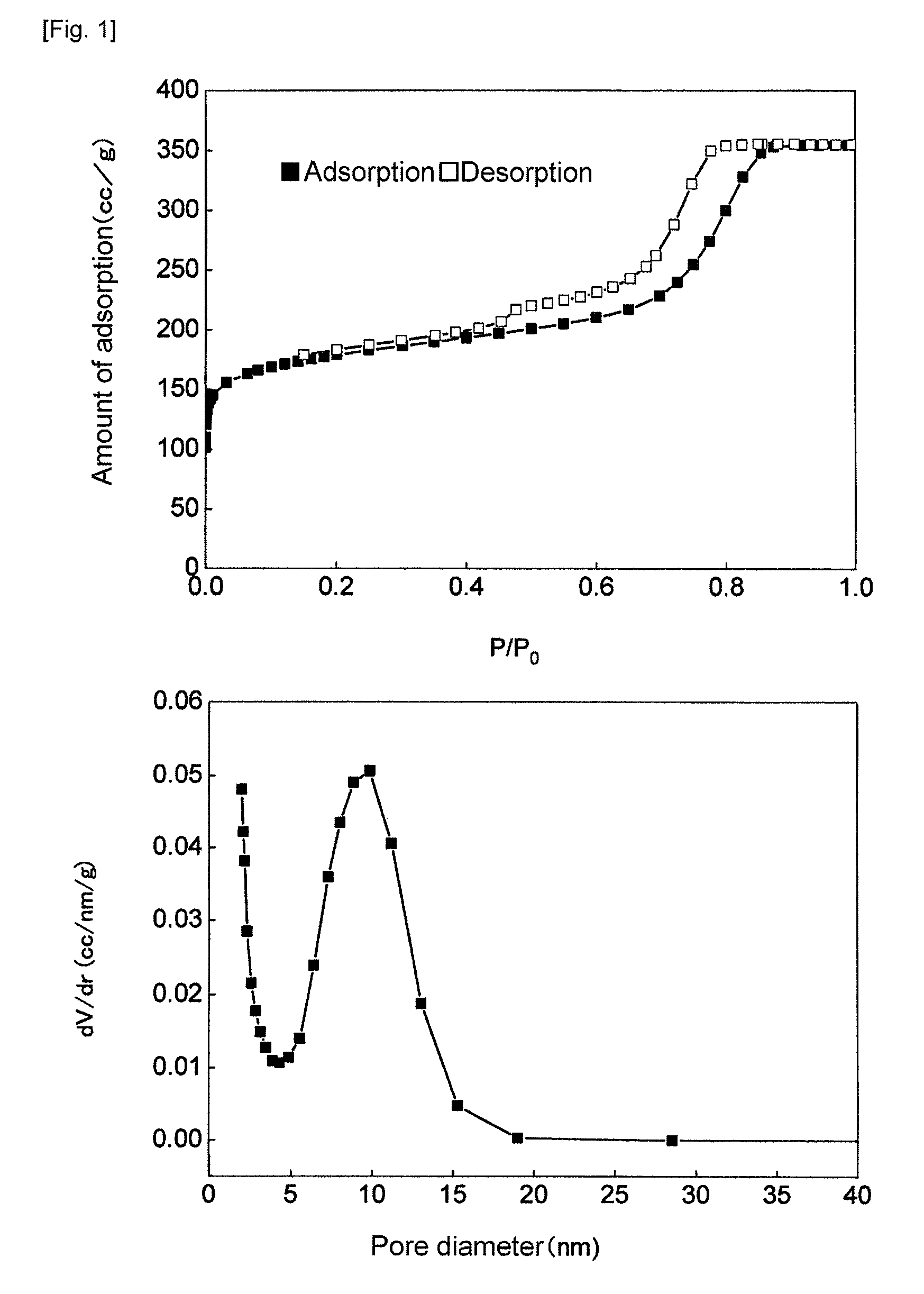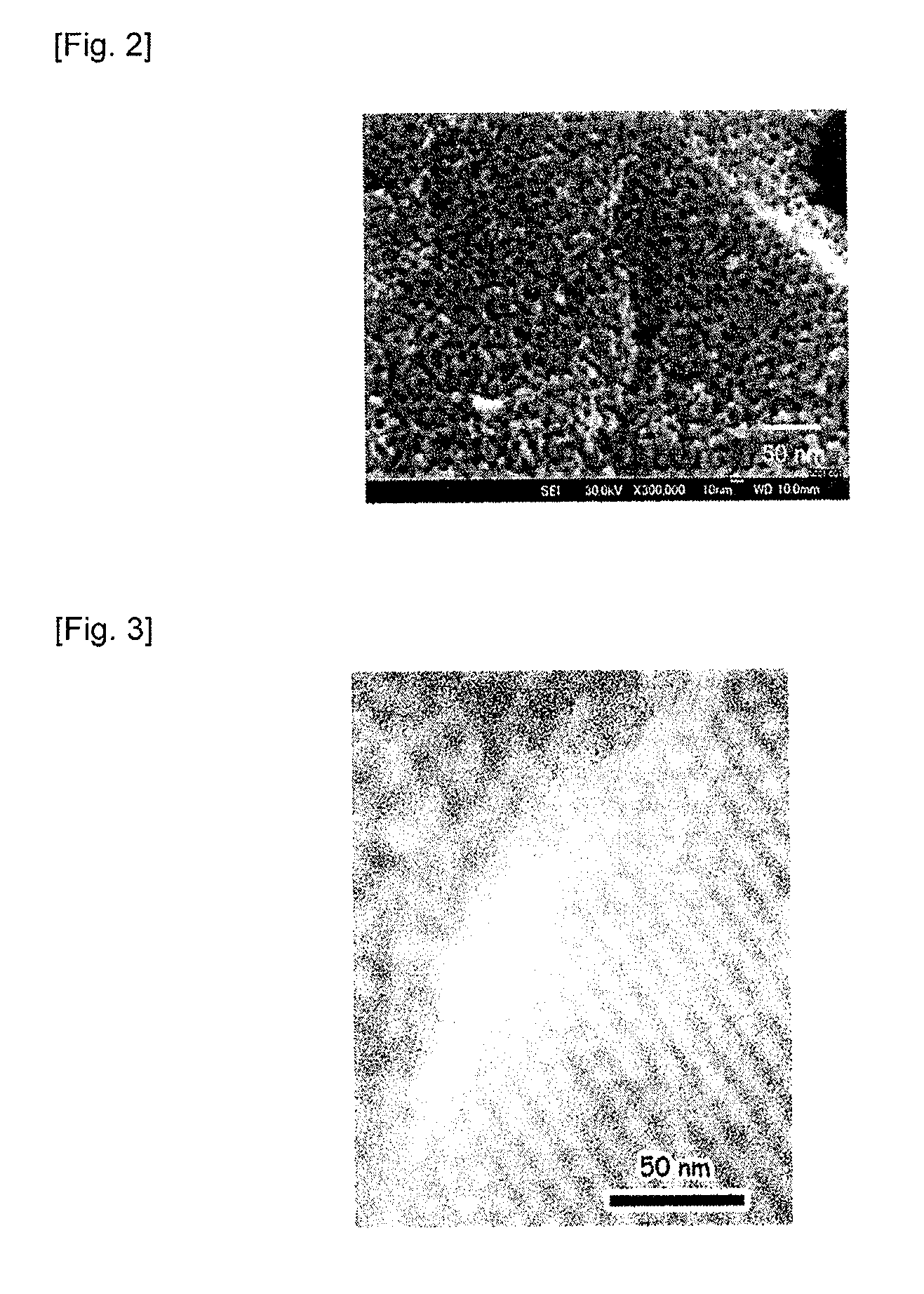Electrode catalyst for a fuel cell, and fuel cell using the same
- Summary
- Abstract
- Description
- Claims
- Application Information
AI Technical Summary
Benefits of technology
Problems solved by technology
Method used
Image
Examples
example 1
Synthetic Example 1 of a Mesoporous Carbon Material
Acidic Condition
[0098]Resorcinol (manufactured by Wako Pure Chemical Industries Ltd.) in an amount of 1.65 g was dissolved in 4.35 g of deionized water / 5.75 g of ethanol (manufactured by Wako Pure Chemical Industries Ltd.) / 0.15 mL of 5M hydrochloric acid (manufactured by Wako Pure Chemical Industries Ltd.). To the resultant solution, 0.945 g of Pluronic F-127 (manufactured by SIGMA) was added, to dissolve the resultant mixture completely. Then, 1.2 g of triethyl orthoacetate (manufactured by Wako Pure Chemical Industries Ltd.) and 1.35 g of 37% formaldehyde manufactured by Wako Pure Chemical Industries Ltd.) were added thereto, and the resultant mixture was stirred at 30° C. for 20 minutes. This solution was poured into a Teflon (registered trademark) container, which was then heated at 105° C. for 6 hours in an air blowing thermohygrostat (DMK300, manufactured by Yamato Scientific Co., Ltd.), to polymerize resorcinol and formaldehy...
synthetic example 2
of a Mesoporous Carbon Material
Alkaline Condition
[0103]The reaction was run in the same manner as in Synthetic Example 1, except that 1.0 mL of 0.5M NaOH (manufactured by Wako Pure Chemical Industries Ltd.) was used in place of hydrochloric acid in Synthetic Example 1. As a result, 0.8 g of a mesoporous carbon material was obtained as a black powder.
(Specific Surface Area of the Mesoporous Carbon Material Obtained in Synthetic Example 1 and Average Diameter of Mesopores)
[0104]The measurement of adsorption of nitrogen to the product obtained in Synthetic Example 1 was made, using an independent multi-port-type specific surface area / pore distribution measuring device (QUADRASORB SI, manufactured by Qantachrome).
[0105]The mesoporous carbon material in an amount of 0.067 g, which was dried at 200° C. for 2 hours as a pretreatment, was utilized in measurement. As a result, it was found that the specific surface area was 600 cm2 / g and the average pore diameter was 7 to 8 nm. (FIG. 1)
(SEM ...
example 2
Production of a Mesoporous Carbon Membrane
[0129]Resorcinol (manufactured by Wako Pure Chemical Industries Ltd.) in an amount of 0.41 g was dissolved in 1.09 g of deionized water / 1.44 g of ethanol (manufactured by Wako Pure Chemical Industries Ltd.) / 0.375 mL of 5M hydrochloric acid (manufactured by Wako Pure Chemical Industries Ltd.). To the resultant solution, 0.236 g of Pluronic F-127 (manufactured by SIGMA) was added, to dissolve the resultant mixture completely. Then, 0.30 g of triethyl orthoacetate (manufactured by Wako Pure Chemical Industries Ltd.) and 0.34 g of 37% formaldehyde manufactured by Wako Pure Chemical Industries Ltd.) were added thereto, and the resultant mixture was stirred at 30° C. for 20 minutes. Then, 3 μL of this solution was cast, on a carbon rod (manufactured by Tokai Carbon), which was then heated at 95° C. for 6 hours in an air blowing thermohygrostat (DMK300, manufactured by Yamato Scientific Co., Ltd.), to polymerize resorcinol and formaldehyde.
[0130]Th...
PUM
 Login to View More
Login to View More Abstract
Description
Claims
Application Information
 Login to View More
Login to View More - R&D
- Intellectual Property
- Life Sciences
- Materials
- Tech Scout
- Unparalleled Data Quality
- Higher Quality Content
- 60% Fewer Hallucinations
Browse by: Latest US Patents, China's latest patents, Technical Efficacy Thesaurus, Application Domain, Technology Topic, Popular Technical Reports.
© 2025 PatSnap. All rights reserved.Legal|Privacy policy|Modern Slavery Act Transparency Statement|Sitemap|About US| Contact US: help@patsnap.com



